SQL Count Function
In this article, we will discuss the COUNT function in SQL, different ways of using it, and how to combine it with other keywords like GROUP BY and HAVING.
1. Introduction
Many times, the information we want from a database table is not available in a single row but in a group of rows or in the result of a mathematical calculation. That is, the data in the group of rows need to be combined or a value expression calculated to obtain a single value of useful business information. To extract data in such cases, SQL (Structured Query Language) provides us with operations that are called aggregate functions: AVG, COUNT, MIN, MAX, SUM. All these aggregate functions return a single value.
2. Salient Features
COUNT is an aggregate function that counts the number of rows in each group. The most basic aggregation is when you specify a *, which will tell you how many rows are there in the result set, including rows containing duplicate and Null values.
If you specify a column name, COUNT tells how many non-null values are present in the column.
The GROUP BY clause runs after the WHERE clause has been evaluated. Here, we want the database server to group the result set into groups based on some column(s). These are specified using the GROUP BY keywords. The system will collect the rows with the same values in these specified columns, into a group. It is important to remember that the GROUP BY clause refers to columns generated by the FROM and WHERE clauses and cannot use any expression that appears in the SELECT clause.
For any queries, we will need to get extra columns along with columns generated by aggregate functions. These columns are added to the SELECT clause and should also be added in the GROUP BY clause.
We need not specify columns in the GROUP BY clause. Instead, we can use ordinal positions that correspond to each column position in the SELECT part of the query.
While the COUNT function determines the number of elements in each group, sometimes we may not want the duplicate values of a column from all members of the group. To achieve this, we use the DISTINCT keyword along with the column name. However, we cannot use DISTINCT with COUNT(*).
Sometimes, want to do second-level filtering on the grouped rows. For this, we use the HAVING operator to apply filter condition(s) on the grouped result set. The HAVING BY clause can be used without a GROUP BY clause in which case, the HAVING BY clause filters all rows returned from the WHERE clause as if they are a single group. One key point here is that the WHERE clause cannot have aggregate functions whereas the HAVING clause can contain.
The ORDER BY keywords can be put at the end of a SQL statement. It sorts the data based on the columns specified to it. The default sorting is ascending order, so if we want to get the result set in reverse order, we use the keyword DESC.
3. Tables and Data
We will use three tables to demonstrate the usage of queries using COUNT. The tables are: departments and employees pertaining to the HR function and a book_sales table of a book_store database.
The following diagram shows the structure of these tables.

In the employees table, each employee (including managers) has his/her own employee_id and they have their manager’s employee_id in the manager_id column. The department managers have their manager_id as NULL.
The book_store database has six titles and monthly sales of each book are recorded in the book_sales table. The month column is an integer, so 1 is used for January and 12 for December. The quantity column has the sales number and if there are no sales of a particular book in the month, the quantity is zero. In effect, there are six rows every month, one per book.
4. SQL Count Function – Examples
In this section, we demonstrate the usage of the COUNT function in SELECT queries on the data in the employees and departments tables as well as the book_sales table. For each example, we first state the business requirement and then show its implementation as a SELECT query. Along with some notes, screenshots of the result set are given below each query.
4.1 How many employees are there in each department?
SELECT department_id "Department Id", COUNT(*) "No. of employees" FROM employees GROUP BY department_id;
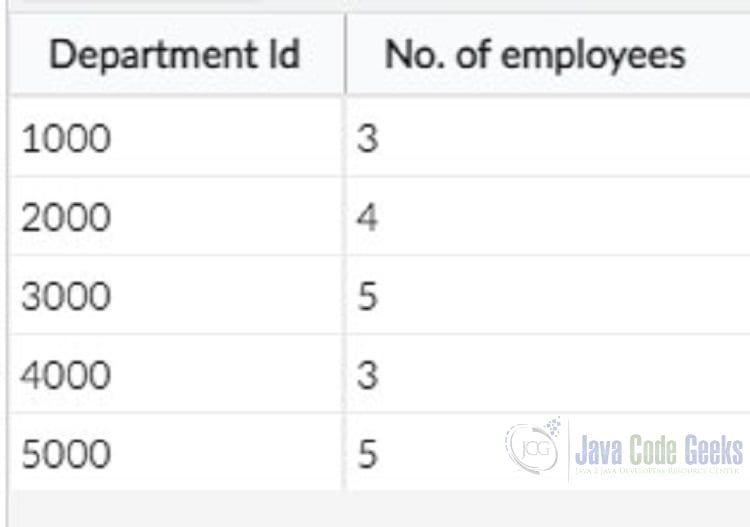
4.2 Which departments have employee count more than three?
For this requirement, we need to use GROUP BY and HAVING clauses.
SELECT department_id "Department Id", COUNT(*) "No. of employees" FROM employees GROUP BY department_id HAVING COUNT(*) > 3;
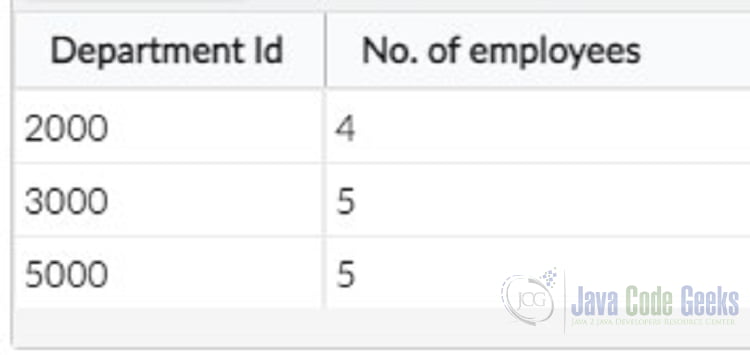
4.3 Department and employee count
Let’s say the business requirement is: We need department names with employee count arranged in decreasing order of employee count. For this requirement, we have to use the DESC keyword.
SELECT name Department, COUNT(employee_id) "No. of employees" FROM employees e INNER JOIN departments d ON e.department_id = d.department_id GROUP BY e.department_id ORDER BY COUNT(employee_id) DESC;
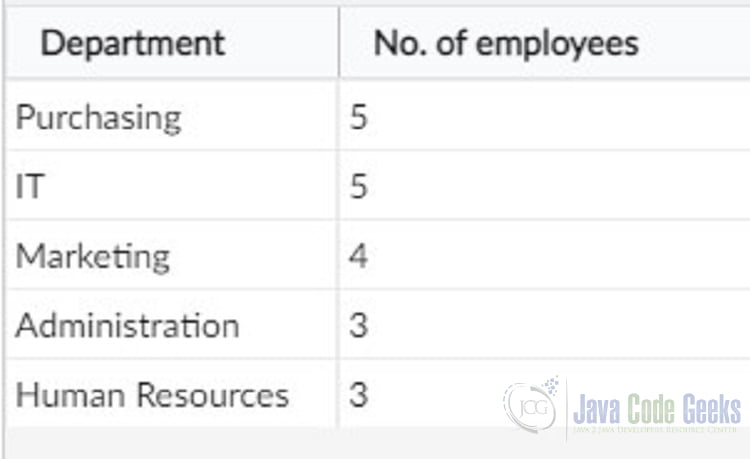
4.4 Department and manager names
Suppose management asks that we want a more refined report than the previous one. Instead of department_ids, we want department names with department manager names. This requirement needs two JOINs. We need to take two instances of the employees table and join each with a separate instance of the departments table.
SELECT e1.first_name "Manager first name", e1.last_name "Manager last name", d1.name Department, COUNT(e2.employee_id) "No. of employees" FROM employees e1 JOIN departments d1 ON e1.department_id = d1.department_id, employees e2 JOIN departments d2 on e2.department_id = d2.department_id WHERE d1.department_id = d2.department_id AND e1.manager_id IS NULL AND e2.manager_id IS NOT NULL GROUP BY e1.first_name, e1.last_name, e2.department_id ORDER BY COUNT(e2.employee_id) DESC;

4.5 Zero-sale months
Let’s say we are asked to find out, for each book, how many months were there with no sales? For this case, the required rows can be retrieved by checking if quantity is zero.
SELECT book_id, COUNT(quantity) "Zero sales months" FROM book_sales WHERE quantity = 0 GROUP BY book_id;

4.6 Monthly sales
Suppose we are asked to report in each month, how many of the six books were sold and what are the total copies sold in that month. We combine COUNT with SUM aggregate function.
SELECT month Month, COUNT(quantity) "Num books sold", SUM(quantity) "Monthly sales" FROM book_sales WHERE quantity > 0 GROUP BY month;
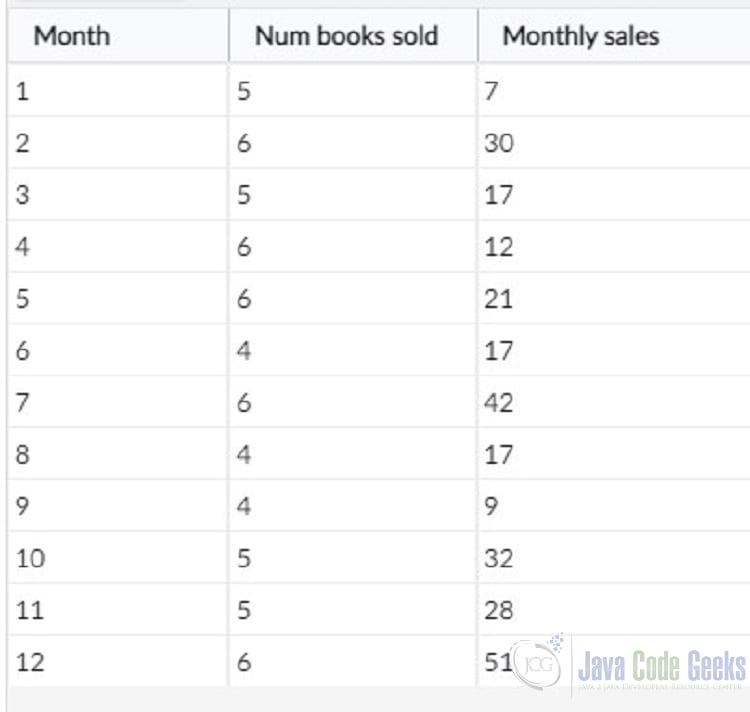
4.7 Months in which books were sold and annual sales
If the management tells us they want to know for each book, the number of months in which sales happened and its annual sales reported with book title in decreasing order of sales. For this requirement, we combine COUNT(*) with SUM and use DESC.
SELECT title Title, COUNT(*) "Sale months", SUM(quantity) "Annual sales" FROM book_sales bs JOIN books b ON b.book_id = bs.book_id WHERE quantity > 0 GROUP BY b.book_id ORDER BY SUM(quantity) DESC;
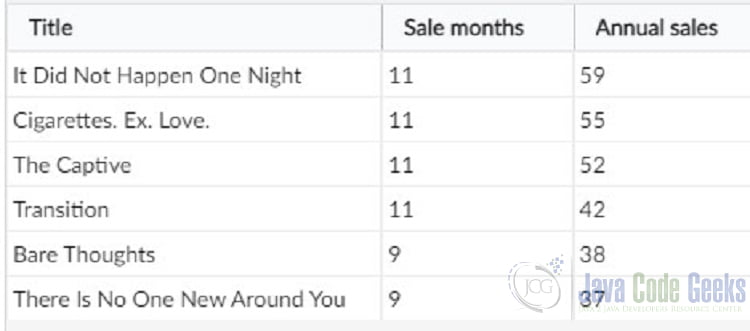
4.8 Last quarter sales
Let’s say the requirement is to get sales for the last quarter only. To get the groups for the last quarter of the year, we need to use the filter month greater than 9.
SELECT month Month, title Title, SUM(quantity) "Monthly sales" FROM book_sales bs JOIN books b ON b.book_id = bs.book_id GROUP BY month, title HAVING month > 9 ORDER BY month, SUM(quantity) DESC
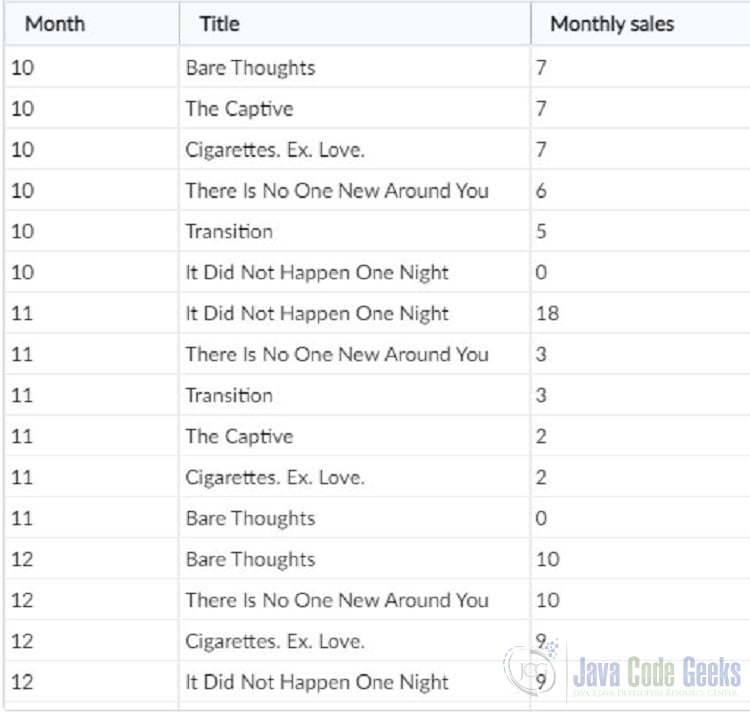
5. Download the Source Code
This article was a tutorial on various use cases of the SQL COUNT function. The SQL source code for creating the tables, inserting the sample data, and all queries discussed in this article are available in a zip file.
You can download the full source code of this example here: SQL Count Function
Last updated on Feb. 24th, 2022



Very informative Thanks Mahboob ji for sharing